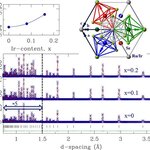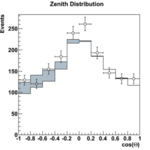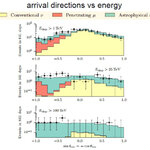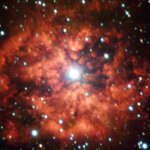Physics
Cryptography aims to secure communication. Eve should not be able to eavesdrop on the communication between Alice and Bob. Quantum cryptography is 100% secure in as far as the physics is concerned. However, it is unsatisfying if this security is merely promised by a still new and even partially controversial theory. Who wants to trust their most important secrets to something that may be wrong? I am indebted to Matthew Saul Leifer, a researcher in the field of quantum information at the Perimeter Institute for Theoretical Physics, because the way he formulated it to me helps understanding the…

The Poster session of Neutrino Telescopes XVI will take place tonight in Venice, at the first floor of the beautiful Palazzo Franchetti. Poster submitters have produced excerpts for the conference blog, so you can also get a summary of the presented results. The blog offers sixteen excerpts:
CALDER: Cryogenic light detectors for rare event searches
A novel spectrometer for neutrino experiments
Searches for short-baseline neutrino oscillations with the T2K off-axis near detector
Appearance of rare physics phenomena in the Opera experiment
Muon and neutrino energy reconstruction…

At the XVI Neutrino Telescopes conference going on this week in Venice there was a nice presentation on the results of the Borexino experiment. The text below is a writeup of the highlights from the talk, given by Cristiano Galbiati from Princeton University. For other writeups from the conference see the conference blog.
The Borexino detector is located in the Gran Sasso laboratories in central Italy. Borexino measures solar neutrinos, relying on scintillation light with very low energy threshold, good position reconstruction by time of flight measurement, and good energy resolution. The…

Synchrotron Light Source II (NSLS-II) at Brookhaven National Laboratory only achieved first light a few weeks ago and already collaborators at the X-Ray Powder Diffraction (XPD) beamline have tested a setup that yielded data on thermoelectric materials. The work was part of the commissioning activities for the XPD beamline, a process that fine-tunes the settings of beamline equipment to ready the facility for first scientific commissioning experiments in mid-March on its way to full user operations later in the year.
To test the optical performance and components of the beamline, the…

(The XVIth edition of "Neutrino Telescopes" is going on in Venice this week. The writeup below is from a talk by M.Nakahata at the morning session today. For more on the conference and the results shown and discussed there, see the conference blog.)
SK is a collaboration of 120 people from 34 institutions in 7 countries. It is a 50kton water detector. Data taking started in 1996. At present it is in its fourth phase of raunning. It has higher than 99% efficiency above 4MeV for neutrinos.
Atmospheric neutrinos are produced by cosmic ray interactions. Neutrinos travel 10-10000km before…

During the first afternoon session of the XVI Neutrino Telescopes conference (here is the conference blog, which contains a report of most of the lectures and posters as they are presented) Francis Halzen gave a very nice account of the discovery of cosmogenic neutrinos by the IceCube experiment, and its implications. Below I offer a writeup - apologizing to Halzen if I misinterpreted anything.
At high energy the sky is dominated by cosmic rays. There’s a thousand protons per every gamma ray, and that is the region where we want to do neutrino astronomy. Neutrinos as cosmic messengers are…

The XVI edition of "Neutrino Telescopes" is about to start in Venice today. In the meantime, I have started to publish in the conference blog a few excerpts of the posters that compete for the "best poster award" at the conference this week. You might be interested to check them out:
CALDER: Cryogenic Light Detectors for Rare Event Searches
A Novel Spectrometer for Neutrino Experiments
Searches for Short-Baseline Neutrino Oscillations with the T2K Off-Axis Near Detector
Appearance of Rare Physics Phenomena in The Opera Experiment
I will post more poster excerpts today and…

International researchers have reported a nanoparticle (74 nm in diameter) that can be used as a contrast agent for six different medical imaging techniques:
Near IR
CT Scanning
Fluorescence Imaging
Photoacoustic Imaging
PET Scanning
Cerenkov-Luminescence Imaging
The core of the particle is covered by a porphyrin-phospholipid (PoP) wrapper. The initial tests were conducted on a turkey breast as the closest simulator to the human breast tissue.
Applications:
Addition of a targeting molecule to the surface of the nanoparticles, allowing them to be absorbed by cancerous cells. This will allow…

Astrophysicists from USA and Germany have discovered the first strange non-chaotic attractor1 in space: a star, name KIC 5520878 - a part of the variable star2 family, that pulsates at characteristic frequencies3 fitting the Golden Ratio of 1.62.The discovery was made when the researchers were scanning data from the Kepler Telescope for evidence supporting that advanced extra-terrestrial civilizations use variable stars2 for inter-galaxy communication.
Applications:
This discovery could help clear up the physics behind such variable stars.
It will help astronomers to better classify these…

By Gabriel Popkin, Inside Science
(Inside Science) -- For all the progress physicists have made in figuring out the universe, they still don't know some pretty basic things. Why, for example, do fundamental particles possess the specific values of mass that they have? Presently, physicists have no explanation for this and similar questions.
They do know something pretty significant, however. If the masses of particles or the values of fundamental constants were much different from what physicists have measured, carbon-based intelligent beings might not be here to measure them, because…